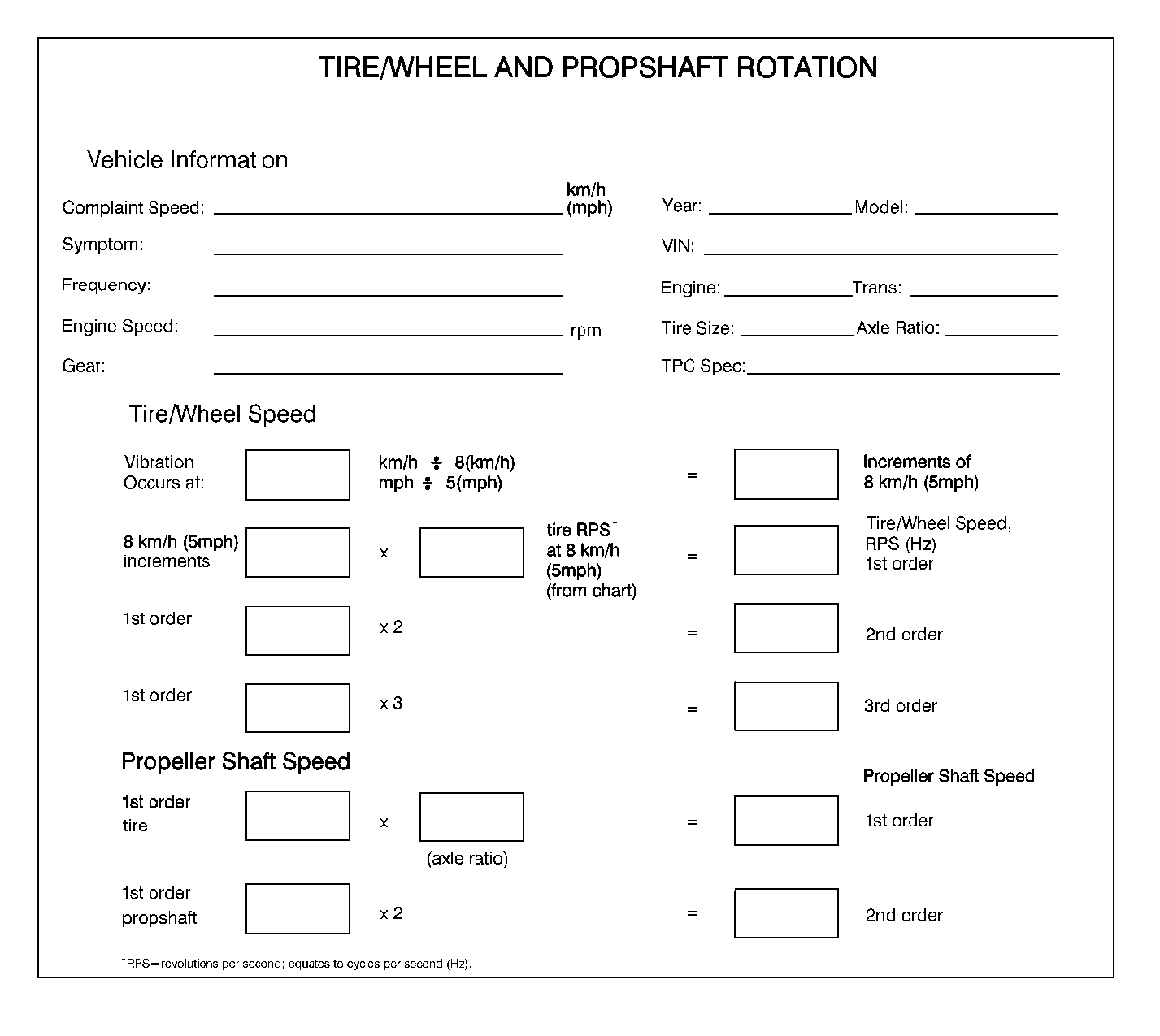Tire and Wheel Rotational Speed Calculation
A size P235/75R15 tire rotates ONE complete revolution per second (RPS) or 1 Hz, at a vehicle speed of 8 km/h (5 mph). This means that at 16 km/h (10 mph), the same tire will make 2 complete revolutions in one second, 2 Hz, and so on.
Tire Size | Tread | RPS (Hz) 8 km/h (5 mph) |
|---|---|---|
P225/55R16 | ALS | 1.10 |
P235/45R17 | ALS | 1.12 |
P235/45R17 | HWY | 1.12 |
Tread Code | ||
ALS | All - Weather | |
HWY | Freeway | |
- According to tire size, determine the tire rotation speed at vehicle speed 8 km/h (5 mph). See Tire Rotational Speed Table.
- Determine the number of increments that are present, based on the vehicle speed 8 km/h (5 mph) at which the disturbance occurs.
- Determine the rotational speed of the tires in RPS, or Hz, at the specific vehicle speed (km/h, mph) at which the disturbance occurs.
- Compare the rotational speed of the tires at the specific vehicle speed at which the disturbance occurs with the dominant frequency recorded on the J 38792-A during testing. If the frequencies match, then a first-order disturbance related to the rotation of the tire/wheel assemblies is present.
- To compute higher order tire/wheel assembly rotation related disturbances, multiply the rotational speed of the tires at the specific vehicle speed at which the disturbance occurs, by the order number:
For example: According to the Tire Rotation Speed Table, a P235/45R17 tire makes 1.12 revolutions per second or Hz at a vehicle speed of 8 km/h (5 mph). This means that for every increment of 8 km/h (5 mph) in vehicle speed, the tire rotation increases by 1.12 revolutions per second (Hz).
For example: Assume that a disturbance occurs at a vehicle speed of 96 km/h (60 mph) 96 km/h (60 mph) has 12 INCREMENTS of 8 km/h (5 mph). A speed of 96 km/h (60 mph) has 12 INCREMENTS of 8 km/h (5 mph):
96 km/h (60 mph) divided by 8 km/h (5 mph) = 12 increments
For example: To determine the tire rotational speed at 96 km/h (60 mph), multiply the number of increments of 8 km/h (5 mph) by RPS.
12 (increments) X 1.12 Hz = 13.44 Hz (rounded to 13 Hz)
If the frequency does not match, then the disturbance may be related to a higher order of tire/wheel assembly rotation.
13 Hz X 2 (2 order) = 26 Hz second-order tire/wheel assembly rotation related
13 Hz X 3 (3 order) = 39 Hz third-order tire/wheel assembly rotation related
If any of these computations match the frequency of the disturbance, a disturbance of that particular order, relating to the rotation of the tire/wheel assemblies is present.
Drive Shaft Rotational Speed Calculation
- Determine the first order rotational speed of the driveshaft (RPS(Hz)), based on the first-order rotational speed of the tire/wheel assemblies.
- Compare the rotational speed of the tires at the specific vehicle speed at which the disturbance occurs with the dominant frequency recorded on the J 38792-A during testing. If the frequency matches, then a first-order disturbance related to the rotation of the driveshaft is present.
- To compute a second order driveshaft rotation related disturbance, multiply the first order rotational speed of the driveshaft at the specific vehicle speed at which the disturbance occurs, by the order number of 2:
13 Hz X 3.42 Drive axle ratio (final drive ratio) = 44.46 Hz (rounded to 44 Hz) first-order driveshaft rotation related.
If the frequency does not match, then the disturbance may be related to the second-order of the drive rotation.
44 Hz X 2 (2 order) = 88 Hz second-order tire/wheel assembly rotation related
If the computation matches the frequency of the disturbance, a disturbance relating to the second-order rotation of the driveshaft is present.
Component Rotational Speed Worksheet
Utilize the following worksheet as an aid in calculating the first, second and third order of tire/wheel assembly rotational speed and the first and second order of driveshaft rotational speed related disturbances that may be presented in the vehicle.
If after completing the Tire/Wheel Rotation Worksheet, the frequencies calculated do NOT match the dominant frequency of the disturbance recorded during testing, either recheck the data, or attempt to rematch the figures allowing for 1½-8 km/h (1-5 mph) of speedometer error.
If the possible tire/wheel assembly and/or driveshaft rotational speed related frequencies still do not match the dominant frequency of the disturbance, the disturbance is most likely torque/load sensitive.
If after completing the Tire/Wheel Rotation Worksheet, one of the frequencies calculated DOES match the dominant frequency of the disturbance, the disturbance is related to the rotation of that component group, (tire/wheel assembly or driveshaft related).

